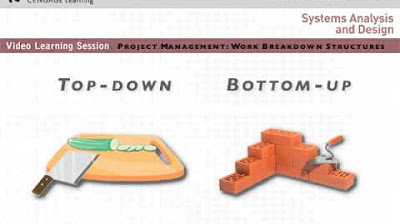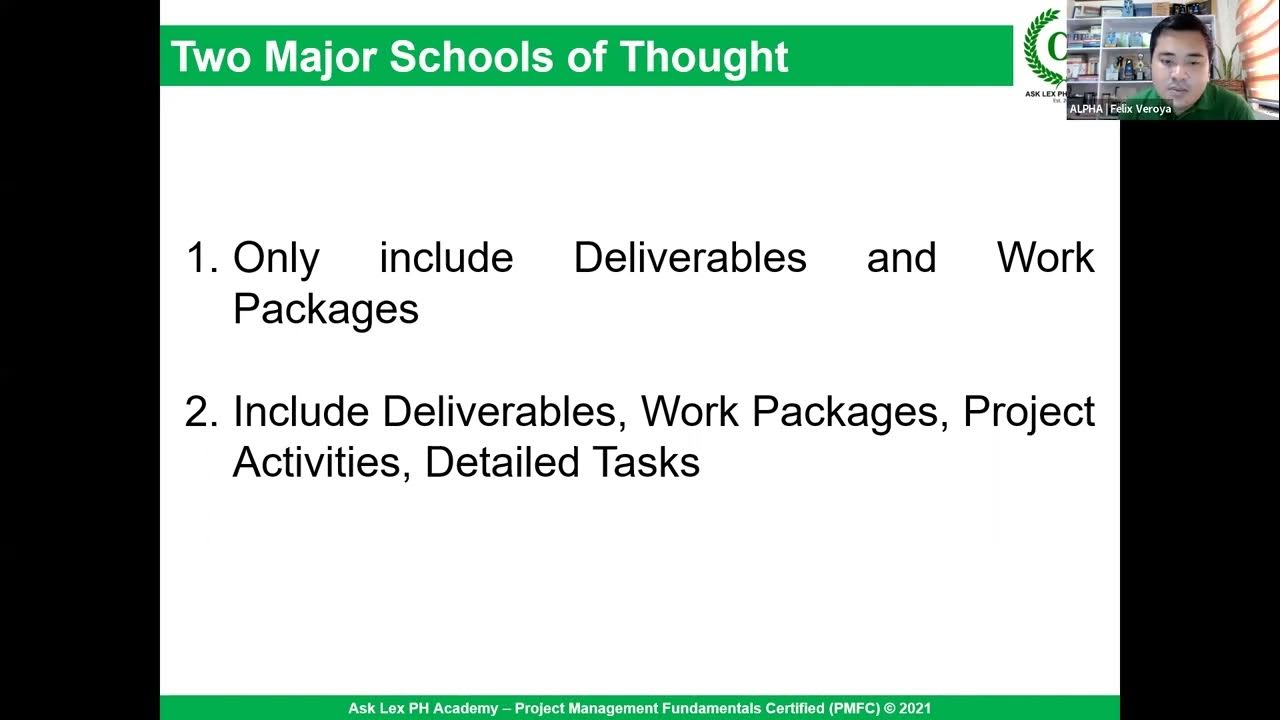Work Breakdown Structure demonstration
Summary
TLDRThis video demonstrates how to effectively facilitate a Work Breakdown Structure (WBS) using Post-it notes. The presenter introduces two techniques: a traditional one-to-many method, where the project manager gathers input from the group, and the 'Deli Technique,' which promotes independent participation by distributing Post-it notes to all team members. The Deli Technique encourages broader involvement, faster idea generation, and more comprehensive input. Afterward, the team reviews, adjusts, and refines the WBS for accuracy. This approach not only boosts engagement but also helps identify missing or misaligned tasks efficiently.
Takeaways
- 😀 Post-it notes can be a valuable tool for facilitating a Work Breakdown Structure (WBS) session, especially for brainstorming.
- 😀 Despite initial skepticism, Post-it notes are useful for engaging teams and generating ideas, even in a low-tech format.
- 😀 Starting with a high-level structure, such as phasing or categories, helps prevent the WBS process from bogging down.
- 😀 A simple, structured approach like categorizing into 'before trip,' 'during trip,' and 'after trip' helps set the context for organizing tasks.
- 😀 The first technique, where the project manager controls the process, can suffer from delays as participants take time to speak up and contribute.
- 😀 The 'Dorothy Effect' describes a common issue where only a few outspoken participants dominate the discussion, leaving others disengaged.
- 😀 The Deli Technique, or 'normative group technique,' encourages independent work by all participants, helping avoid dominance by a few voices.
- 😀 In the Deli Technique, participants independently write down tasks on Post-it notes and place them where they think they belong, which ensures more diverse input.
- 😀 The Deli Technique is advantageous because it ensures everyone contributes and provides a broader range of perspectives, leading to better buy-in.
- 😀 After using the Deli Technique, it's important to review the gathered items, add what's missing, and remove irrelevant or out-of-scope items to refine the WBS.
- 😀 The Deli Technique is a time-efficient way to gather a large volume of ideas quickly and engage participants without overwhelming them or leading to groupthink.
Q & A
What is the primary purpose of a Work Breakdown Structure (WBS)?
-The primary purpose of a Work Breakdown Structure (WBS) is to break down a complex project into smaller, manageable tasks or components, making it easier to plan, execute, and monitor the progress of the project.
Why does the speaker prefer using Post-it notes for creating a WBS?
-The speaker prefers using Post-it notes because they serve as effective brainstorming tools, allowing for quick and flexible input from all participants. Despite initial skepticism about the low-tech nature of the method, it helps encourage involvement and can be easily adapted to fit various situations.
What is the 'Dorothy Effect,' and how does it relate to WBS facilitation?
-The 'Dorothy Effect' refers to a dynamic in meetings where only a few people do most of the talking, while others are less involved. In the context of WBS facilitation, this effect can result in unequal participation, which can limit the effectiveness of brainstorming sessions.
What is the main difference between the traditional method and the 'Deli Technique' for creating a WBS?
-The main difference is that in the traditional method, the project manager leads the process, writing down and organizing input from the team one by one. In contrast, the 'Deli Technique' involves participants working independently and anonymously to write down their ideas on Post-it notes, which are then organized collectively.
What is the key characteristic of the Deli Technique?
-The key characteristic of the Deli Technique is that participants work independently and anonymously. Each person writes down their ideas on Post-it notes, which ensures that all contributions are equally valued and that the process encourages more engagement from everyone.
How does the Deli Technique help to avoid the Dorothy Effect?
-The Deli Technique prevents the Dorothy Effect by ensuring that everyone participates equally. Since all team members write down their ideas independently, quieter participants are not overshadowed by more outspoken individuals, leading to a more balanced contribution.
Why does the speaker emphasize getting 'volume' in the WBS process rather than worrying about the order of tasks?
-The speaker emphasizes volume to ensure that as many ideas as possible are collected in a short amount of time. The focus at this stage is on capturing all the relevant activities, and the order of tasks can be addressed later in the process.
What are the benefits of having Post-it notes displayed on a wall or whiteboard during a WBS session?
-Displaying Post-it notes on a wall or whiteboard helps visualize the project structure, making it easier for the team to see what has been included and what might be missing. It also allows for quick adjustments and collaborative feedback.
What does the speaker mean by 'get a lot of volume in a short amount of time' when using the Deli Technique?
-The speaker means that the Deli Technique allows for the collection of a large number of ideas in a short period. Since each participant works independently, the group can generate a comprehensive list of activities quickly, without waiting for lengthy discussions.
What should be done after using the Deli Technique to create the initial WBS?
-After using the Deli Technique to generate the initial WBS, the team should review the results, move items around as necessary, remove any tasks that are out of scope, and identify any gaps that need to be filled. This process helps refine the WBS into a more accurate and complete structure.
Outlines

Dieser Bereich ist nur für Premium-Benutzer verfügbar. Bitte führen Sie ein Upgrade durch, um auf diesen Abschnitt zuzugreifen.
Upgrade durchführenMindmap

Dieser Bereich ist nur für Premium-Benutzer verfügbar. Bitte führen Sie ein Upgrade durch, um auf diesen Abschnitt zuzugreifen.
Upgrade durchführenKeywords

Dieser Bereich ist nur für Premium-Benutzer verfügbar. Bitte führen Sie ein Upgrade durch, um auf diesen Abschnitt zuzugreifen.
Upgrade durchführenHighlights

Dieser Bereich ist nur für Premium-Benutzer verfügbar. Bitte führen Sie ein Upgrade durch, um auf diesen Abschnitt zuzugreifen.
Upgrade durchführenTranscripts

Dieser Bereich ist nur für Premium-Benutzer verfügbar. Bitte führen Sie ein Upgrade durch, um auf diesen Abschnitt zuzugreifen.
Upgrade durchführen5.0 / 5 (0 votes)






